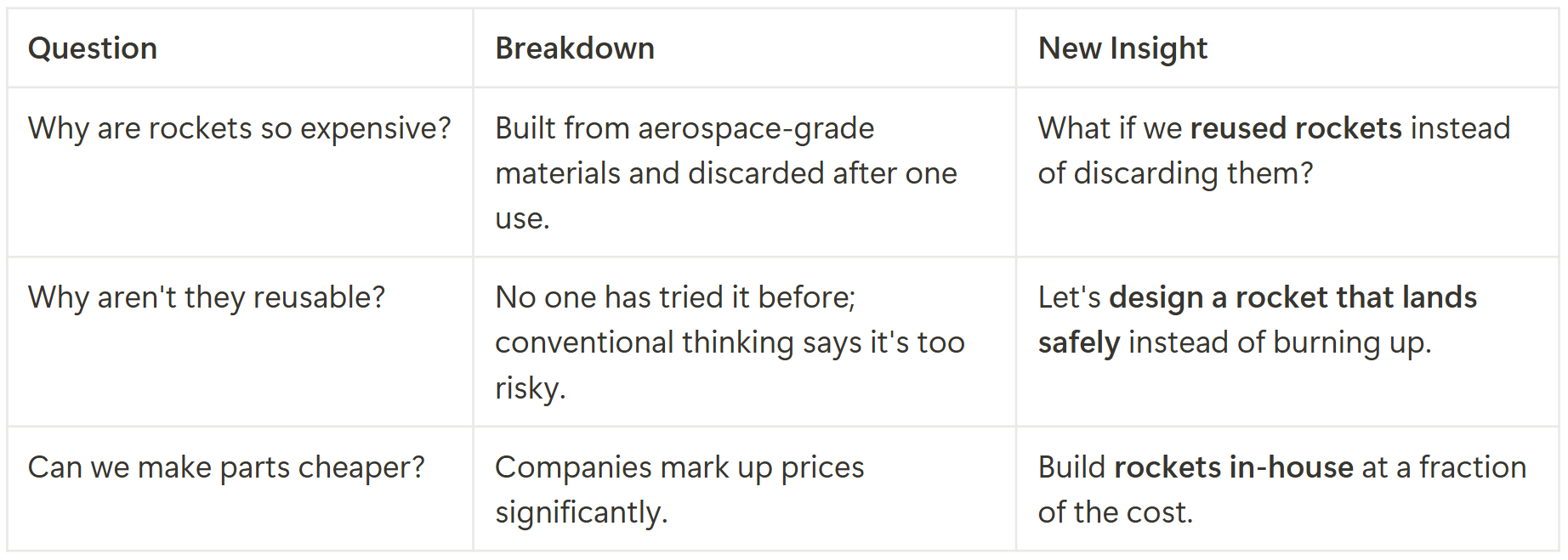What if you could solve problems like Aristotle or Richard Feynman? First Principles Thinking is a powerful mental model that helps you break down complex problems and create innovative solutions from the ground up. Instead of relying on assumptions or conventional wisdom, this approach forces you to asks questions and find fundamental truths.
1. What is First Principles Thinking?
First Principles Thinking is a method of breaking down a problem into its most basic elements and then building up a solution from scratch. Instead of accepting existing knowledge as fact, this method challenges you to ask "why?" repeatedly until you reach foundational truths.

Traditional Thinking (Analogy Thinking):
- "This is how it's always been done, so let's improve it slightly."
- Example: "All cars need gasoline, so we should focus on making gas engines more efficient."
First Principles Thinking:
- "What are the basic truths? Can we rebuild from scratch?"
- Example: "Cars are meant to transport people. Is gasoline the only way to power them? What if we used electricity instead?" (This is how Tesla disrupted the auto industry!)
✅ Extern Tip:
Using First Principles Thinking in business strategy, product development, and problem-solving allows you to find unconventional solutions and create breakthroughs.
2. Why Use First Principles Thinking?
- Break Free from Conventional Wisdom – Avoids the trap of "this is how it's always been done."
- Encourages Deep Understanding – Forces you to question assumptions and gain clarity.
- Leads to Innovation – Helps in creating disruptive solutions rather than incremental improvements.
- Boosts Problem-Solving Skills – Makes it easier to tackle complex challenges.
💡 Did You Know?
Elon Musk credits First Principles Thinking for helping him create Tesla and SpaceX. He questioned the cost of rockets and realized that instead of buying expensive ones, he could build reusable rockets from cheaper raw materials.
3. How to Apply First Principles Thinking
Follow these four steps to apply First Principles Thinking effectively:
Step 1: Identify the Problem or Assumption
- What challenge are you trying to solve?
- What assumptions are you making about the problem?
Example: "Batteries for electric cars are too expensive."
Step 2: Break It Down to First Principles
- Ask, “Why is this true?”
- Keep asking “why” until you reach a fundamental truth.
Example:
- Why are batteries expensive? → The materials used (lithium, cobalt) are costly.
- Why are those materials costly? → They are mined and require expensive processes.
- Can we create batteries using different materials?
Step 3: Rebuild from the Ground Up
- Once you have first principles, explore new solutions instead of improving old ones.
Example:
- What if we design batteries with cheaper, abundant materials?
- Can we recycle old batteries instead of mining new ones?
Step 4: Test & Iterate
- Experiment with your new solution.
- If it fails, refine your first principles and try again.
4. Real-World Example: Reinventing Space Travel
When Elon Musk started SpaceX, the cost of launching a rocket was $65 million. Instead of accepting this, he used First Principles Thinking:

🚀 Result: SpaceX created reusable rockets, cutting launch costs by 90%.
5. Externship Tip: How to Apply First Principles Thinking in Projects
During externships, students often struggle with limited resources and tight deadlines. First Principles Thinking can help them find smarter solutions.
Example: Suppose you're researching how to improve customer engagement for an e-commerce company.

✅ New Insight:
Instead of increasing ad spending, what if we improve product recommendations, personalize emails, or offer loyalty rewards?
By questioning why customers aren’t engaging instead of blindly following industry norms, we discover better solutions.
6. Final Thoughts
First Principles Thinking is a superpower that helps you think creatively, solve problems effectively, and challenge assumptions. Instead of accepting what exists, you rebuild from scratch and create groundbreaking solutions.
🚀 Challenge for the Week:
1️⃣ Think of a problem you're facing.
2️⃣ Break it down into first principles by asking “why” multiple times.
3️⃣ Rebuild a new solution from scratch instead of tweaking old ones.
Let’s Practice!
1️⃣ Productivity Challenge:
"Why do I struggle to complete tasks efficiently?"
Break it down: Identify distractions, inefficient workflows, or unclear priorities.
Rebuild: Create a custom productivity system from scratch instead of copying generic time management tips.
2️⃣ Career Growth Challenge:
"Why am I not making progress in my career or externship?"
Break it down: Lack of skills, networking, or clear goals?
Rebuild: Define the core skills and knowledge needed and create a personalized learning path.
3️⃣ User Experience Challenge (for Business or Projects):
"Why do customers or users not engage with our product/service?"
Break it down: Is it usability, lack of trust, or no real need?
Rebuild: Design a solution based on fundamental customer needs rather than minor fixes.


.png)

